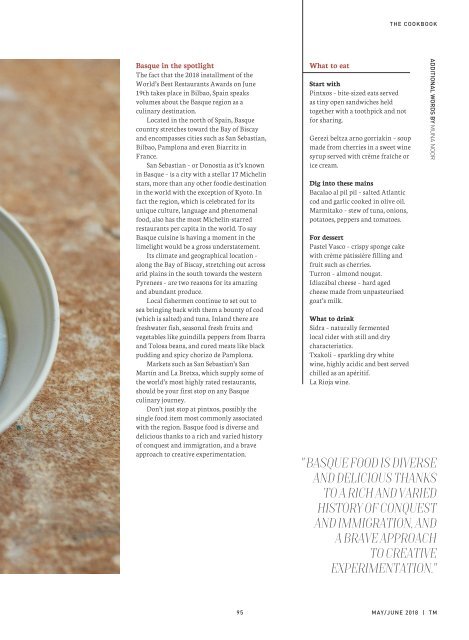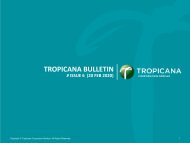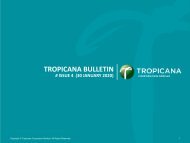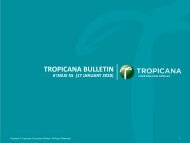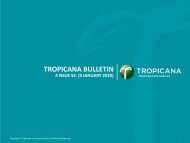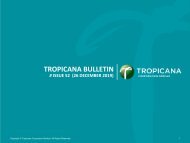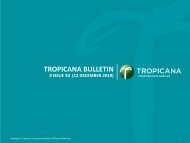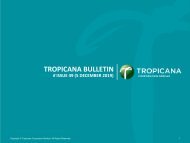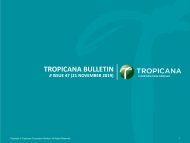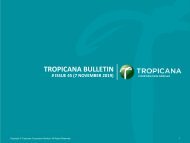Tropicana Magazine May-Jun 2018 #118: Winner Takes All
Issue.#118 (Winner Takes All) Nu Infinity shares their origin stories on forming their own dream team. A guide to exotic Istanbul, Major golf tournaments and more.
Issue.#118 (Winner Takes All) Nu Infinity shares their origin stories on forming their own dream team. A guide to exotic Istanbul, Major golf tournaments and more.
You also want an ePaper? Increase the reach of your titles
YUMPU automatically turns print PDFs into web optimized ePapers that Google loves.
THE COOKBOOK<br />
Basque in the spotlight<br />
The fact that the <strong>2018</strong> installment of the<br />
World’s Best Restaurants Awards on <strong>Jun</strong>e<br />
19th takes place in Bilbao, Spain speaks<br />
volumes about the Basque region as a<br />
culinary destination.<br />
Located in the north of Spain, Basque<br />
country stretches toward the Bay of Biscay<br />
and encompasses cities such as San Sebastian,<br />
Bilbao, Pamplona and even Biarritz in<br />
France.<br />
San Sebastian – or Donostia as it’s known<br />
in Basque – is a city with a stellar 17 Michelin<br />
stars, more than any other foodie destination<br />
in the world with the exception of Kyoto. In<br />
fact the region, which is celebrated for its<br />
unique culture, language and phenomenal<br />
food, also has the most Michelin-starred<br />
restaurants per capita in the world. To say<br />
Basque cuisine is having a moment in the<br />
limelight would be a gross understatement.<br />
Its climate and geographical location –<br />
along the Bay of Biscay, stretching out across<br />
arid plains in the south towards the western<br />
Pyrenees – are two reasons for its amazing<br />
and abundant produce.<br />
Local fishermen continue to set out to<br />
sea bringing back with them a bounty of cod<br />
(which is salted) and tuna. Inland there are<br />
freshwater fish, seasonal fresh fruits and<br />
vegetables like guindilla peppers from Ibarra<br />
and Tolosa beans, and cured meats like black<br />
pudding and spicy chorizo de Pamplona.<br />
Markets such as San Sebastian’s San<br />
Martín and La Bretxa, which supply some of<br />
the world’s most highly rated restaurants,<br />
should be your first stop on any Basque<br />
culinary journey.<br />
Don’t just stop at pintxos, possibly the<br />
single food item most commonly associated<br />
with the region. Basque food is diverse and<br />
delicious thanks to a rich and varied history<br />
of conquest and immigration, and a brave<br />
approach to creative experimentation.<br />
What to eat<br />
Start with<br />
Pintxos – bite-sized eats served<br />
as tiny open sandwiches held<br />
together with a toothpick and not<br />
for sharing.<br />
Gerezi beltza arno gorriakin – soup<br />
made from cherries in a sweet wine<br />
syrup served with crème fraîche or<br />
ice cream.<br />
Dig into these mains<br />
Bacalao al pil pil – salted Atlantic<br />
cod and garlic cooked in olive oil.<br />
Marmitako – stew of tuna, onions,<br />
potatoes, peppers and tomatoes.<br />
For dessert<br />
Pastel Vasco – crispy sponge cake<br />
with crème pâtissière filling and<br />
fruit such as cherries.<br />
Turron – almond nougat.<br />
Idiazábal cheese – hard aged<br />
cheese made from unpasteurised<br />
goat’s milk.<br />
What to drink<br />
Sidra – naturally fermented<br />
local cider with still and dry<br />
characteristics.<br />
Txakoli – sparkling dry white<br />
wine, highly acidic and best served<br />
chilled as an apéritif.<br />
La Rioja wine.<br />
ADDITIONAL WORDS BY MUNA NOOR<br />
" Basque food is diverse<br />
and delicious thanks<br />
to a rich and varied<br />
history of conquest<br />
and immigration, and<br />
a brave approach<br />
to creative<br />
experimentation."<br />
95 MAY/JUNE <strong>2018</strong> | TM


